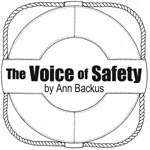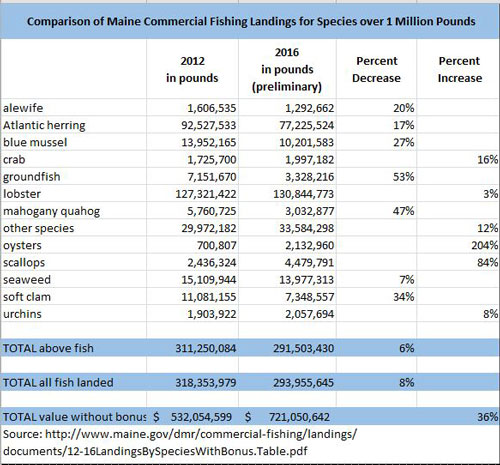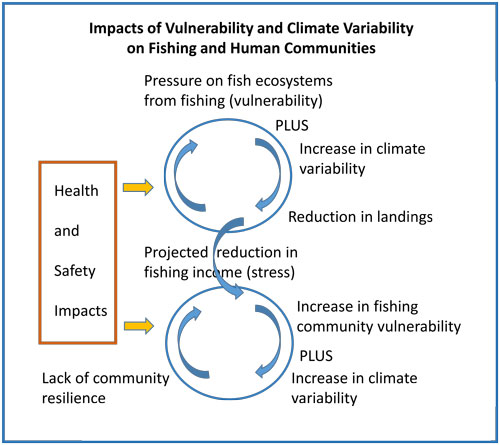Climate Change and Safety
How might they mesh?
Ann Backus, MS

How do climate change and safety mesh? What fabric can we weave using the concepts of climate change and fishing safety and health? Where are the intersections?
It is hard to know how to start with this complex story that can only be explained in its most basic terms in an article such as this.
Let’s start with the landings data from the Maine Department of Marine Resources (current to February 2017). An analysis of the landings of species over 1 million pounds (see Table) shows that landings for seven species decreased whereas landings for six species increased. To be sure, there are a number of stories (regarding regulations, profitability, etc.) behind these numbers that may explain the landings results. But clearly, groundfish, alewives, and Atlantic herring took a big hit as did some shellfish—blue mussels, quahogs and soft clams.
For the purposes of this discussion, we can think of these data as showing a biological response. The research literature mentions fishing pressure and climate change as two major drivers of biological response. According to R. Ian Perry, et al in their article, “Sensitivity of marine systems to climate change and fishing” (2010), fishing practices that put pressure on the stocks result in a reduction of diversity (e.g., loss of member age groups which in turn affects reproduction), a change in where and when the fish show up (i.e., spatial, temporal changes), a loss of population sub-units (e.g., large or old fish), and a change in life-cycle characteristics (e.g., earlier reproduction).
These changes, collectively understood as biological response, render the fish stocks and ecosystem more vulnerable to climate change.


Climate Change
Under the heading “climate change” we can make a distinction between climate variability and climate trends. Climate variability includes the increase in the severity and/or frequency of large storms or wildfires ? acute events. Climate trends include ocean acidification, changes in sea level and changes in air and water temperature, to name several. The impact on fish due to climate variability can be noticed in a relatively short period of time, whereas the impact due to climate trends has a longer time course. Both the size of the impact due to variability and the size of the impact due to climate trends are conditioned by the degree of vulnerability of the marine ecosystem.
Vulnerability and Variability
The schematic diagram I created for this article depicts a scenario in which, when hit with climate variability, fish stocks made vulnerable by fishing pressure will demonstrate a biologic response, which we will log as reduced landings, and likely a corresponding reduction in income, although this is not always the case. At this point, as the upper circle suggests, the fisherman with decreased income will likely try to fish more, thus putting more pressure on the fish stocks and increasing their vulnerability.
This is the time when health and safety could be compromised. During financial stress fishermen may not undertake needed maintenance or check/replace safety equipment; they may take chances with the weather or unintentionally forget to check fuel lines, hose connections, batteries, through-hull fittings, etc.
As we know and as the lower circle in the diagram shows, a community of financially stressed fishermen becomes vulnerable itself. Should climate variability or other event impact this community, the community will have trouble rebounding for lack of resilience.
The health and safety impacts at the community level are many and serious as we learned from the Gulf of Mexico communities and Puerto Rico during and after the three major hurricanes of 2017. Lack of water, electricity, shelter, food and access to health care put millions of people at risk for days and weeks – even months.
Reducing the Contribution to Climate Change
There are steps fishermen can take to avoid contributing to climate change. The simplest one is to purchase only low VOC (volatile organic compound) products. This means purchasing latex paint and avoiding the use of strippers and solvents. Hamilton Marine recently introduced a new latex buoy paint under its own label. There are multiple bright colors named after Maine fishing ports! While VOCs are not in themselves greenhouse gases (GHG) that contribute to global warming, they do interact in the atmosphere to produce ozone (O3) and carbon dioxide (CO2) which are GHGs. The second step, which again a sizeable number of fishermen have undertaken, is to repower with EPA compliant Tier II, III or IV engines. These engines are designed to reduce the emissions of particulate matter, carbon monoxide (CO) and non-methane hydrocarbons, all of which contribute directly or indirectly to global warming.
Sustainability and resilience
And although it will not reduce climate change directly, avoiding over fishing will reduce the vulnerability of the marine ecosystem and enhance sustainability in the face of climate variability and climate trends.
At the community level, there is a long list of actions that fishing communities can and are taking to increase resilience and the ability to rebound. From ensuring access to shelter, water, food, backup communication, and electricity to reworking zoning regulations, preparedness will contribute to safety and health. In addition, keeping community organizations strong and community government responsive will help ensure the community has the needed infrastructure and protocols in place to help minimize the effect of a major disaster. Just as the ocean is a web of interdependent species, so the community must recognize and value the interdependence of its members in the service of resilience and sustainability.
Climate and safety are intertwined as well. I hope this article wove a bit of the fabric for you.
Reference: R. Ian Perry, Philippe Cury, Keith Brander, Simon Jennings, Christian Möllman, Benjamin Planque. Sensitivity of marine systems to climate and fishing: Concepts, issues and management responses. Journal of Marine Systems. 79 (2010) 427–435.
Ann Backus, MS is an Instructor in Occupational Health at Harvard School of Public Health, 665 Huntington Ave., Boston MA 02115, 617-432-3327, abackus@hohp.harvard.edu.
